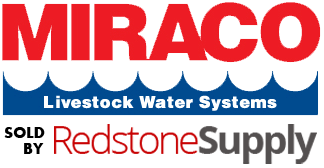Fresh Algae Free Water
Posted by Miraco Waterers on
Good water is essential for livestock health and well-being. Without an adequate food supply that meets their nutritional needs and a constant supply of clean fresh water, livestock will fail. This second requirement can be a difficult one for farmers and ranchers alike. Animals are not only more likely to consume clean water that is algae free, but it also provides fewer health risks for your animals.
The task of keeping a stock tank full of fresh, clean, algae free water is an age old dilemma. Luckily, as time has gone on more and more has been learned regarding this aspect of livestock care. Here we’ll show you some of the best tips for keeping your herds water clean and palatable for your livestock.
Here at Miraco, we know these are problems. That’s why we’ve developed our unique ball founts – They keep your water fresh and clean by closing when the horse isn’t drinking. Still, we all have to do some cleaning once in a while.
Cleaning options
1) Dumping and scrubbing – this is rather harsh work, and needs to be done weekly to be truly effective. You will want to completely drain or dump the tank, and then scrub it  well with a brush or other course medium such as a pumice stone. Completely remove any hint of dirt or algae, allow to completely dry and then refill the tank. This requires that you have a secondary water source available for your livestock.
well with a brush or other course medium such as a pumice stone. Completely remove any hint of dirt or algae, allow to completely dry and then refill the tank. This requires that you have a secondary water source available for your livestock.
2) Daily scooping – this is most effective with a new tank, or a freshly cleaned tank that has been dumped and scrubbed. You will want to get a scrub brush with a long handle, as well as a net such as you’d use to clean a pool or pond. Scoop any large debris or algae from the tank with the net, then use the scrub brush to scrub the edges, as well as any other algae growth from inside the tank. Once you are done scrubbing, you will once more want to use your net to remove any loose debris from the water. This is very time consuming, but works if no other option is available.
Tank additives
Along with cleaning your tank on a regular basis, some find that they can clean the tank less frequently with the use of additives. One thing to keep in mind however, is that some additives can alter the taste of the water which could cause your livestock to stop drinking an adequate amount of water.
1) Bleach – you will want to add 2 - 3 ounces of chlorinated fragrance free bleach to every 100 gallons of water in your tank roughly once a week. (University of Missouri Extension) You will find that you may want to do this more frequently in hot weather than in cold.
2) Copper sulfate – this can be used in very small amounts–about 1/8 of a teaspoon per 100 gallons to kill off any living algae in the tank. Once the algae has died, you will then need to clean the debris from the tank to keep it from coming back.
3) Zinc sulfate – mixed ½ cup per 100 gallons, (Colorado State Extension) zinc sulfate will kill the algae from the tank, and reduce the potential for regrowth.
4) Barley Hay – barley hay has been used more and more frequently as a non-chemical agent for the reduction of algae in standing water. Small bundles of barley hay should be loosely netted and hung into the water in order to allow water and air to move freely through the hay (Purdue Botany Department). This will provide for decomposition of the hay, this process will release chemicals that will prevent algae from producing. It is highly recommended that this be added to an already cleaned tank as it may not destroy algae that are already developed in the tank.
5) Goldfish – For those who are concerned with any complications from the addition of chemicals to their animal’s water supply, the best option is goldfish. These hardy fish will keep most any tank clean without having to be concerned with any potential negative impact upon your livestock. We suggest one fish per 100 gallon’s as they grow you may find that this number can be reduced, but this is a good number to start with and maintain.
Keeping your animal’s water fresh and algae free is important to your herd’s survival. Knowing how to keep the tank clean and algae free is the first step to ensuring that this most basic need is met. Just like their human counterparts animals must have a constant supply of food and water in order to survive. Knowing what it takes to keep your stock tank clean and algae free will take some weight off your shoulders and ensure that you are doing the very best for your livestock.

